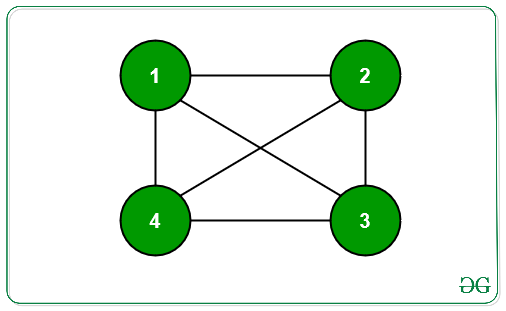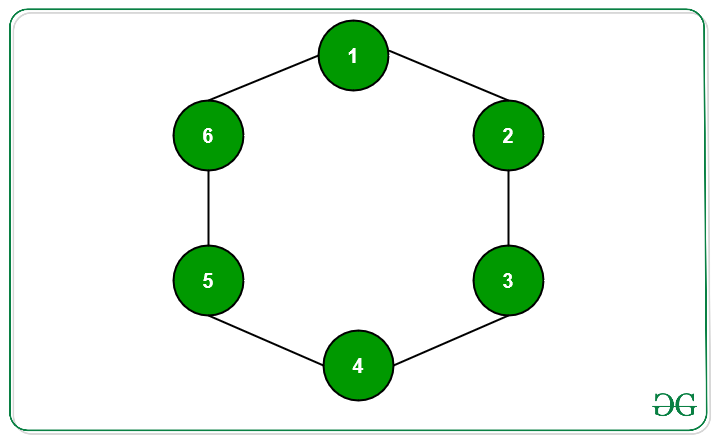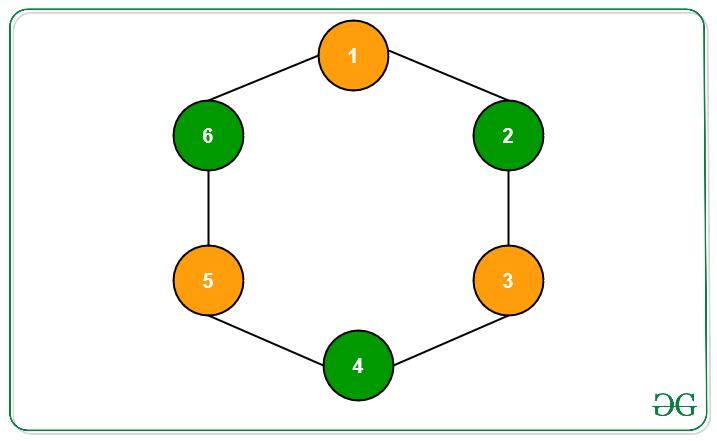给定一个具有V个节点和E个边缘的图形G ,任务是对不超过floor(V / 2)个节点进行着色,以使每个节点在至少1个单位的距离处至少具有一个着色节点。图的任何两个连接节点之间的距离始终正好为1个单位。打印需要着色的节点。
例子:
Input: N = 4,
G:

Output: 1

Input: N = 6,
G:

Output: 3

方法:可以使用BFS遍历解决此问题。请按照以下步骤解决问题:
- 初始化数组奇数[]和偶数[]以存储与源分别处于奇数和偶数个节点距离的节点。
- 从源节点开始,执行BFS遍历,并将距离初始化为0,该距离表示距源节点的距离。根据distance的值将所有节点存储在特定级别的奇数[]或偶数[]中。
- 如果distance为奇数,即(distance&1)为1,则将该节点插入奇数[]。否则,插入even []。
- 现在,使用最少的元素打印数组中的节点。
- 由于奇数距离或偶数距离的节点数中的最小值不超过floor(V / 2) ,因此答案保持正确,因为奇数距离的每个节点都连接到偶数距离的节点,反之亦然。
- 因此,如果到源的偶数距离处的节点数较少,则从even []中打印节点。否则,从奇数[]中打印所有节点。
Illustration:
For the graph G given below,
Source Node S = 1

- even[] = {1, 3, 5}
- odd[] = {2, 6, 4}
- minimum(even.size(), odd.size()) = min(3, 3) = 3
- Hence, coloring either all nodes at odd distance from the source or even distance from the source is correct as both their count is same.
下面是上述方法的实现:
C++
// C++ Program to implement the
// above approach
#include
using namespace std;
// Stores the graph
map > graph;
// Stores the visited nodes
map vis;
// Stores the nodes
// at odd distance
vector odd;
// Stores the nodes at
// even distance
vector even;
// Function to seperate and
// store the odd and even
// distant nodes from source
void bfs()
{
// Source node
int src = 1;
// Stores the nodes and their
// respective distances from
// the source
queue > q;
// Insert the source
q.push({ src, 0 });
// Mark the source visited
vis[src] = 1;
while (!q.empty()) {
// Extract a node from the
// front of the queue
int node = q.front().first;
int dist = q.front().second;
q.pop();
// If distance from source
// is odd
if (dist & 1) {
odd.push_back(node);
}
// Otherwise
else {
even.push_back(node);
}
// Traverse its neighbors
for (auto i : graph[node]) {
// Insert its unvisited
// neighbours into the queue
if (!vis.count(i)) {
q.push({ i, (dist + 1) });
vis[i] = 1;
}
}
}
}
// Driver Program
int main()
{
graph[1].push_back(2);
graph[2].push_back(1);
graph[2].push_back(3);
graph[3].push_back(2);
graph[3].push_back(4);
graph[4].push_back(3);
graph[4].push_back(5);
graph[5].push_back(4);
graph[5].push_back(6);
graph[6].push_back(5);
graph[6].push_back(1);
graph[1].push_back(6);
bfs();
if (odd.size() < even.size()) {
for (int i : odd) {
cout << i << " ";
}
}
else {
for (int i : even) {
cout << i << " ";
}
}
return 0;
} Java
// Java program to implement the
// above approach
import java.util.ArrayList;
import java.util.HashMap;
import java.util.LinkedList;
import java.util.Map;
import java.util.Queue;
class Pair
{
int first, second;
public Pair(int first, int second)
{
this.first = first;
this.second = second;
}
}
class GFG{
// Stores the graph
static Map> graph = new HashMap<>();
// Stores the visited nodes
static Map vis = new HashMap<>();
// Stores the nodes
// at odd distance
static ArrayList odd = new ArrayList<>();
// Stores the nodes at
// even distance
static ArrayList even = new ArrayList<>();
// Function to seperate and
// store the odd and even
// distant nodes from source
static void bfs()
{
// Source node
int src = 1;
// Stores the nodes and their
// respective distances from
// the source
Queue q = new LinkedList<>();
// Insert the source
q.add(new Pair(src, 0));
// Mark the source visited
vis.put(src, 1);
while (!q.isEmpty())
{
// Extract a node from the
// front of the queue
int node = q.peek().first;
int dist = q.peek().second;
q.poll();
// If distance from source
// is odd
if ((dist & 1) != 0)
{
odd.add(node);
}
// Otherwise
else
{
even.add(node);
}
// Traverse its neighbors
for(Integer i : graph.get(node))
{
// Insert its unvisited
// neighbours into the queue
if (!vis.containsKey(i))
{
q.add(new Pair(i, (dist + 1)));
vis.put(i, 1);
}
}
}
}
// Driver code
public static void main(String[] args)
{
graph.put(1, new ArrayList<>());
graph.put(2, new ArrayList<>());
graph.put(3, new ArrayList<>());
graph.put(4, new ArrayList<>());
graph.put(5, new ArrayList<>());
graph.put(6, new ArrayList<>());
graph.get(1).add(2);
graph.get(2).add(1);
graph.get(2).add(3);
graph.get(3).add(2);
graph.get(3).add(4);
graph.get(4).add(3);
graph.get(4).add(5);
graph.get(5).add(4);
graph.get(5).add(6);
graph.get(6).add(5);
graph.get(6).add(1);
graph.get(1).add(6);
bfs();
if (odd.size() < even.size())
{
for(int i : odd)
{
System.out.print(i + " ");
}
}
else
{
for(int i : even)
{
System.out.print(i + " ");
}
}
}
}
// This code is contributed by sanjeev2552 Python3
# Python3 Program to implement the
# above approach
# Stores the graph
graph = dict()
# Stores the visited nodes
vis = dict()
# Stores the nodes
# at odd distance
odd = []
# Stores the nodes at
# even distance
even = []
# Function to seperate and
# store the odd and even
# distant nodes from source
def bfs():
# Source node
src = 1;
# Stores the nodes and their
# respective distances from
# the source
q = []
# Insert the source
q.append([ src, 0 ]);
# Mark the source visited
vis[src] = 1;
while (len(q) != 0):
# Extract a node from the
# front of the queue
node = q[0][0]
dist = q[0][1]
q.pop(0);
# If distance from source
# is odd
if (dist & 1):
odd.append(node);
# Otherwise
else:
even.append(node);
# Traverse its neighbors
for i in graph[node]:
# Insert its unvisited
# neighbours into the queue
if (i not in vis):
q.append([ i, (dist + 1) ]);
vis[i] = 1;
# Driver code
if __name__=='__main__':
graph[1] = [2, 6]
graph[2] = [1, 3]
graph[3] = [2, 4]
graph[4] = [3, 5]
graph[5] = [4, 6]
graph[6] = [5, 1]
bfs();
if (len(odd) < len(even)):
for i in odd:
print(i, end = ' ')
else:
for i in even:
print(i, end = ' ')
# This code is contributed by rutvik_56输出:
1 3 5时间复杂度: O(V + E)